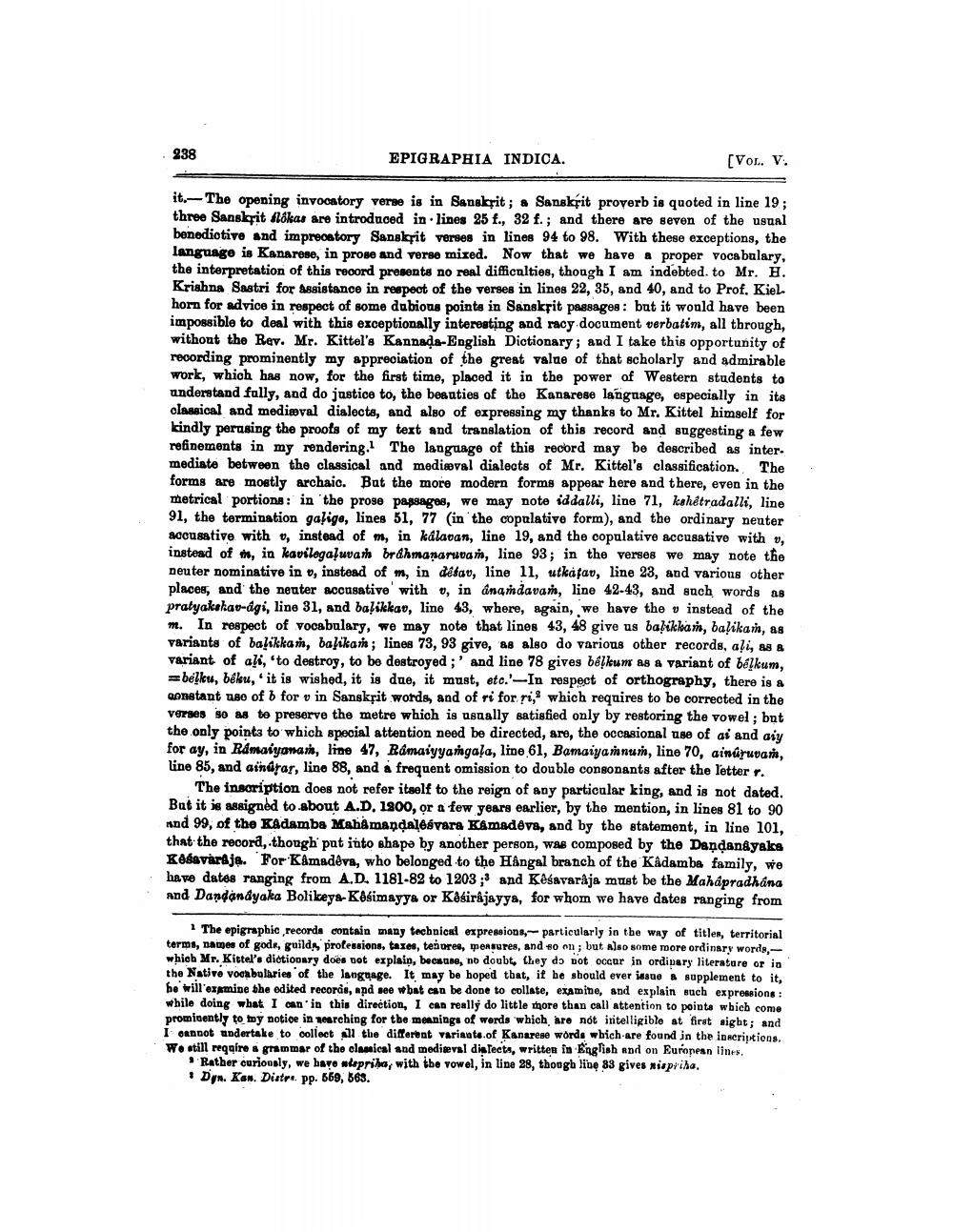________________
238
EPIGRAPHIA INDICA.
[VOL. v.
it.-The opening invocatory verse is in Sanskrit ; a Sanskrit proverb is quoted in line 19; three Sanskrit flókas are introduced in lines 25 f., 32 f.; and there are seven of the usual benedictive and impreostory Sanskrit verses in lines 94 to 98. With these exceptions, the language is Kanarese, in prose and verse mixed. Now that we have a proper vocabulary, the interpretation of this record presente no real difficulties, though I am indebted to Mr. H. Krishna Sastri for Assistance in respect of the verses in lines 22, 35, and 40, and to Prof. Kiel horn for advice in respect of some dubions points in Sanskrit passages: but it would have been impossible to deal with this exceptionally interesting and racy document verbatim, all through, without the Rev. Mr. Kittel's Kannada-English Dictionary; and I take this opportunity of recording prominently my appreciation of the great value of that scholarly and admirable work, which has now, for the first time, placed it in the power of Western students to understand fully, and do justice to, the beauties of the Kanarese language, especially in its classical and medieval dialects, and also of expressing my thanks to Mr. Kittel himself for kindly perasing the proots of my text and translation of this record and suggesting a few refinements in my rendering. The language of this record may be described as inter. mediate between the classical and medieval dialects of Mr. Kittel's classification. The forms are mostly archaic. But the more modern forms appear here and there, even in the metrical portions: in the proge passagas, we may note id dalli, line 71, kshetradalli, line 91, the termination galige, lines 51, 77 (in the copulative form), and the ordinary neuter accusative with o, instead of m, in kálatan, line 19, and the copulative accusative with , instead of s, in kavilegaļuvan brahmanaruvan, line 93; in the verses we may note the neuter nominative in o, instead of m, in detav, line 11, utkafar, line 23, and various other places, and the neuter accusative' with o, in anamdavan, line 42-43, and ench words as pratyakshao-agi, line 31, and balikkao, line 43, where, again, we have the v instead of the m. In respect of vocabulary, we may note that lines 43, 48 give us balikkan, balikan, as variants of balikkan, balikar; lines 73, 93 give, 88 also do various other records, aļi, as a variant of all, 'to destroy, to be destroyed ;' and line 78 gives b&ļkum as a variant of bólkum, =belku, béku, it is wished, it is due, it must, etc.-In respect of orthography, there is a constant nae of for v in Sanskrit words, and of ri for ri, which requires to be corrected in the Verses so as to preserve the metre which is usually satisfied only by restoring the vowel; but the only points to which special attention need be directed, are, the occasional use of as and asy for ay, in Ramaiyananh, line 47, Ramaiyyangala, line 61, Bamaiya ri nurh, line 70, ainúruran, line 85, and aindrar, lino 88, and a frequent omission to double consonants after the letter r.
The inscription does not refer itself to the reign of any particular king, and is not dated. But it is assigned to about A.D. 1800, or a few years earlier, by the mention, in lines 81 to 90 and 99, of the Kadamba Mahåmandalesvara Kamadeva, and by the statement, in line 101, that the record, though pat into shape by another person, was composed by the Dandanayaka Kosavardja. For Kamadeva, who belonged to the Hangal branch of the Kadamba family, we have dates ranging from A.D. 1181-82 to 1203;' and Kesavarája must be the Mahápradhana and Dandanayaka Bolikeya-Kosimayya or Käsirêjayya, for whom we have dates ranging from
The epigraphic records contain many technical expressions, particularly in the way of titles, territorial terms, names of gode, guilds professions, taxes, teñores, measures, and so on; but also some more ordinary words, which Mr. Kittel's dictionary does not explain, because, no doubt they do not occur in ordinary literature or in the Native vocabularies of the language. It may be hoped that, it be should ever issue supplement to it, ho will'
ermine the edited records, apd see what can be done to collate, examine, and explain such expressions : while doing what I can' in this direction, I can really do little more than call attention to points which come promioently to by notice in searching for tbe meanings of werds which are not intelligible at first sight; and IORDOD andertake to collect all the different variaate of Kanarese words which are found in the inscriptions We still reggire a grammar of the clanical and mediteval dialects, written in English and on European lines.
· Rather curiously, we hayo wiepriha, with the vowel, in line 28, though line 88 gives nispriha. • Dyn. Kan. Distre. pp. 669, 563.




